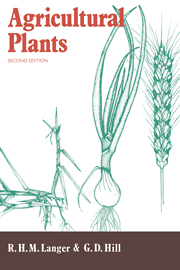Book contents
- Frontmatter
- Contents
- Preface to the first edition
- Preface to the second edition
- 1 World population and crop production
- 2 Plant structure
- 3 Liliaceae
- 4 Poaceae
- 5 Apiaceae
- 6 Asteraceae
- 7 Brassicaceae
- 8 Cannabinaceae
- 9 Chenopodiaceae
- 10 Cucurbitaceae
- 11 Fabaceae
- 12 Lamiaceae
- 13 Linaceae
- 14 Malvaceae
- 15 Papaveraceae
- 16 Solanaceae
- 17 Physiological basis of yield
- Index of specific names
- Subject index
9 - Chenopodiaceae
Published online by Cambridge University Press: 05 June 2012
- Frontmatter
- Contents
- Preface to the first edition
- Preface to the second edition
- 1 World population and crop production
- 2 Plant structure
- 3 Liliaceae
- 4 Poaceae
- 5 Apiaceae
- 6 Asteraceae
- 7 Brassicaceae
- 8 Cannabinaceae
- 9 Chenopodiaceae
- 10 Cucurbitaceae
- 11 Fabaceae
- 12 Lamiaceae
- 13 Linaceae
- 14 Malvaceae
- 15 Papaveraceae
- 16 Solanaceae
- 17 Physiological basis of yield
- Index of specific names
- Subject index
Summary
The Chenopodiaceae, not a large family, with only about 75 genera and 500 to 600 species, contains just one species of agricultural significance, the beets and associated plants (Beta vulgaris). Members of the family are distinctive for one or two reasons. Morphologically they differ from many other dicotyledonous families by having inconspicuous flowers without sepals and petals but with five perianth members. Physiologically the main point of interest is that many Chenopodiaceae are halophytes, plants that are tolerant of high salt concentrations in the soil and that in agricultural practice respond to applications of common salt. This ecological adaptation is usually associated with succulence in these plants and a fine, mealy covering of short, swollen hairs on the leaves. Also characteristic of these plants is their ability to accumulate considerable concentrations of nitrate and nitrite ions which can cause digestive disturbances in animals being fed on them.
BEET (BETA VULGARIS)
This is a variable species, sometimes divided into three subspecies, consisting of mainly biennial plants. They range from those with fleshy leaves with succulent midribs grown as leafy vegetables, such as the garden or silver beet, to plants in which the hypocotyl is swollen like the beetroot and those in which both hypocotyl and taproot are enlarged as in the fodder and sugar beet. Despite this wide variation, all these plants belong to the same species with a diploid chromosome number of 18.
- Type
- Chapter
- Information
- Agricultural Plants , pp. 197 - 208Publisher: Cambridge University PressPrint publication year: 1991



